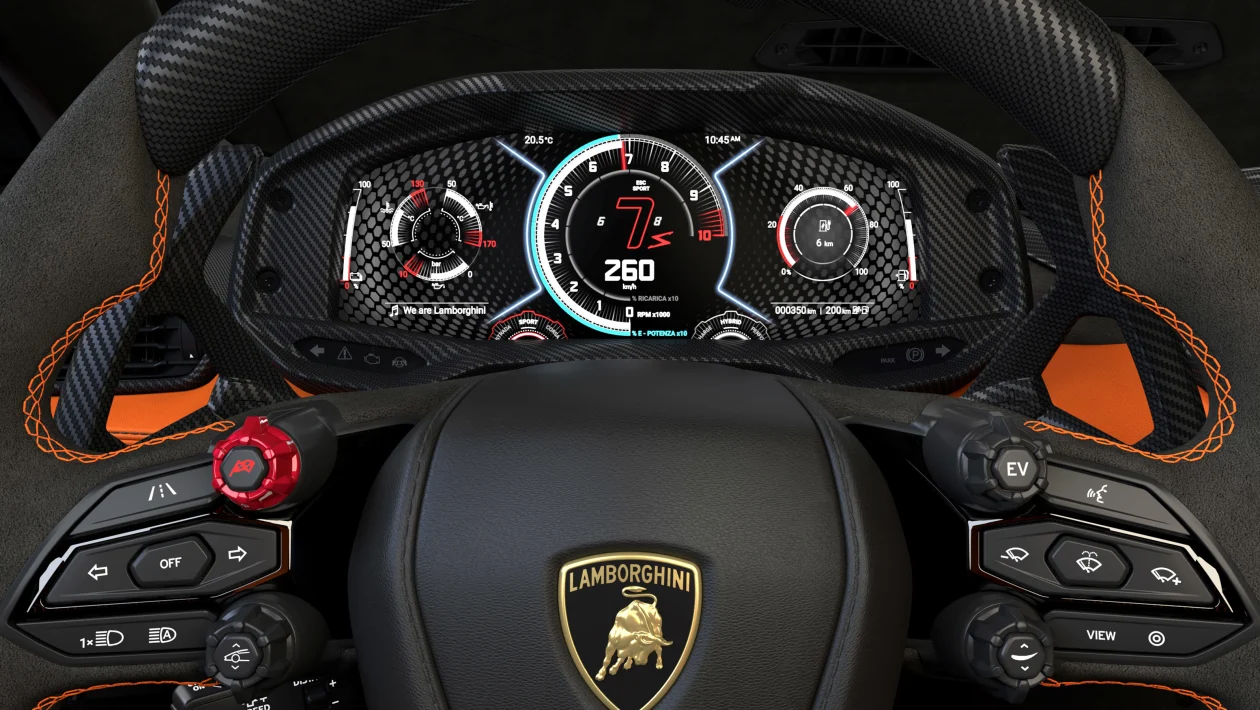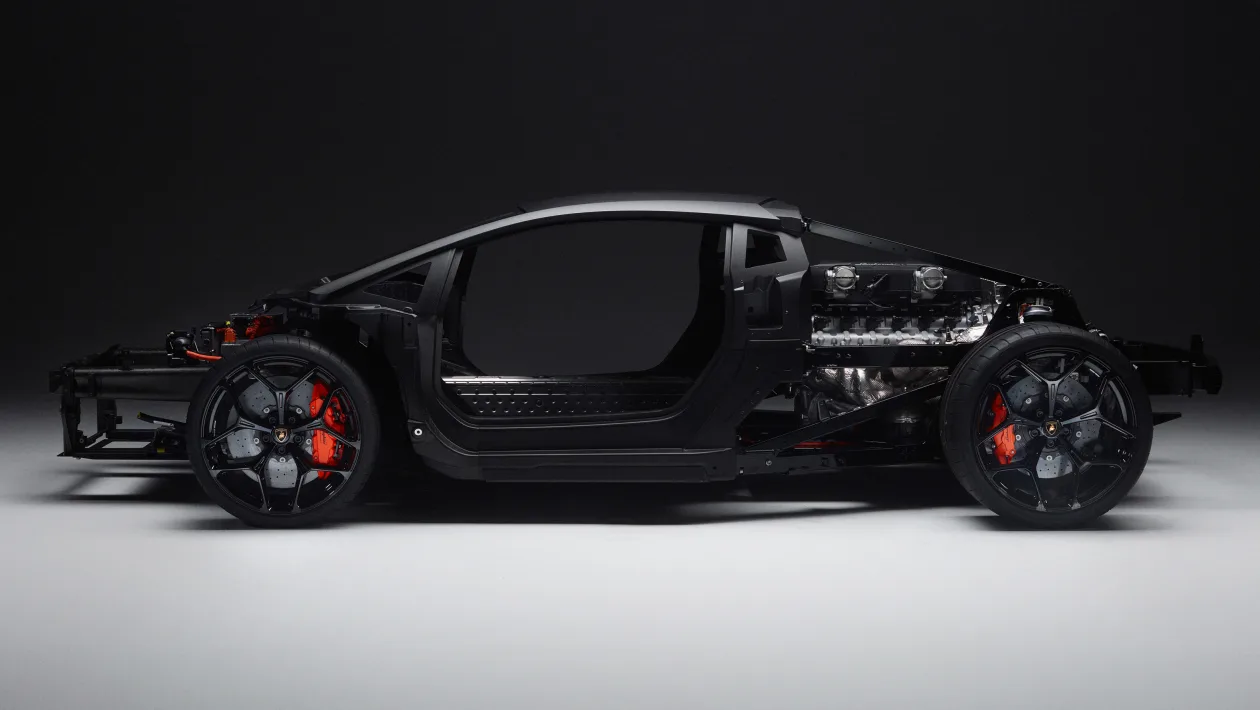More details confirmed for Lamborghini’s new V12 PHEV supercar, set to launch on March 29 as the Aventador’s successor.
Following deep dives into its powertrain and chassis tech, Lamborghini has announced further details of its next-generation flagship supercar. Set to be revealed in full on March 29, the model, codenamed LB744, will launch as the Aventador’s successor, featuring a combination of a 6.5-litre V12 engine and three electric motors.
Given the complexity of this new powertrain, Lamborghini has revealed that drivers will be able to choose from 13 combinations of chassis and powertrain modes. The new hybrid powertrain can operate in three main modes; Recharge (in which the engine charges the battery), Hybrid and Performance. In addition to these, four driving modes aim to provide the driver with fine control over just how the new flagship delivers its performance.
Città (City) offers purely electric driving with reduced drag from the active aero system and comfortable suspension settings, while Strada is for everyday driving with the V12 always on and up to 653kW available. For more sporting driving styles there’s Sport mode with up to 667kW available, a more rear-biased torque balance, faster gear changes and firmer damping, with Corsa providing the full 746kW, chassis and stability settings for neat, tidy, fast lap times and the ability to switch the ESC system off entirely.
In Strada, Sport and Corsa, it’s possible to select any of the three driving modes. For example, in Corsa Performance mode, the torque vectoring provides the most aggressive possible front-end traction and the sharpest throttle map. In Corsa Recharge mode, it keeps the battery primed to help with electric boost out of slow corners.
With Città a pure electric mode, there are 13 possible drive mode settings in the new car in total. If the battery runs flat in Città mode, the V12 fires up to recharge it, a process said to take only a few minutes.
Lamborghini has also revealed aspects of the car’s suspension, brakes and tyres. Like some Aventador and Huracan variants, the new car will feature rear-wheel steering, with the anti-roll bars made 11 and 50 per cent stiffer at the front and rear respectively compared with the final Aventador Ultimae model.
The new supercar will utilise specially developed Bridgestone Potenza Sport tyres, with a 4 per cent broader contact patch at the front than the Aventador Ultimate. The new car features active aerodynamics too, with peak downforce said to be 66 per cent greater than the Ultimae. Carbon ceramic brakes are standard, featuring 10 pistons at the front.
The ‘monofuselage’ chassis
Details of the new model’s rolling chassis have already been disclosed, revealing many of its hard points and proportions. A three-dimensional roof (which channels air to the rear wing), the door outline and a typically extreme shallow-raked windscreen are all visible.
The LB744 is built around a carbonfibre monocoque structure Lamborghini calls ‘monofuselage.’ The monocoque itself is made entirely from carbonfibre and unusually, so is the front subframe and crash structure – even the Rimac Nevera’s innovative carbon chassis uses aluminium for its front crash-absorption structures.
Yes, Lamborghini’s V12 lineage lives on and it remains naturally aspirated, revving to a heady 9500rpm. The 6.5-litre unit (codenamed L545) is related to that of the Aventador, thoroughly re-engineered with new castings, exhaust routing, valve gear and many more revisions besides. Not least because it has been rotated through 180 degrees compared with the Aventador and its post-Miura forebears.
Directly behind the engine is a new, transversely-mounted, in-house developed double-clutch eight-speed transmission, which incorporates one of the three electric motors mounted directly above. That motor also functions as both the starter motor and a generator, with the LB744’s other two motors part of its front e-axle – more on which shortly.
The engine is considered the lightest and most powerful Lamborghini production V12 yet, tipping the scales at 218kg (17kg less than the Aventador’s engine) and generating 607kW at 9250rpm. As a benchmark, the final, most powerful Aventador iteration, the Ultimae, produced 574kW at 8500rpm. Combine this new peak figure with the boost from its trio of electric motors and total output comes to a Ferrari SF90-beating 746kW.
The LB744 is a plug-in hybrid, though Lamborghini prefers to label it a HPEV, for high-performance electrified vehicle, rather than using the PHEV term. Whereas the 2019 Lamborghini Sian V12 hybrid stored its energy in a supercapacitor, the LB744 has a more capacious lithium-ion battery set-up – packaged in a longitudinal, 1550mm-long oblong in the middle of the car (ordinarily the transmission tunnel), its position ensures both protection for the pack in the event of an impact and optimum weight distribution.
Although the LB744 can be plugged in to charge the battery (in just 30 minutes from empty, Lamborghini states), the engine can recharge the battery directly in six minutes, with regenerative energy from the front axle also able to contribute to a charge.
The two electric motors at the front weigh 18.5kg apiece and generate 350Nm of torque each. Lamborghini is particularly excited about the torque vectoring capability they enable, with the motors eliminating the need for the use of brakes for vectoring. The front wheels are powered solely by the motors, with no prop shaft connecting the engine to the front axle.
The LB744 will include fully electric driving modes, offering pure electric drive to all four wheels even in reverse. In its most energy-efficient electric mode, it uses the front wheels only, with the rear electric motor activated based on demand.
The LB744 continues the mid-engined Lamborghini V12 supercar dynasty begun with the Miura in 1966 and continued with the Countach, Diablo, Murcielago and Aventador since. The model’s full name will be announced when the car is revealed in its entirety on March 29.






